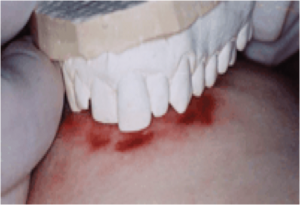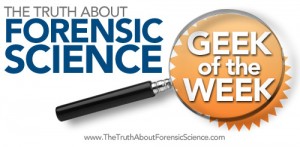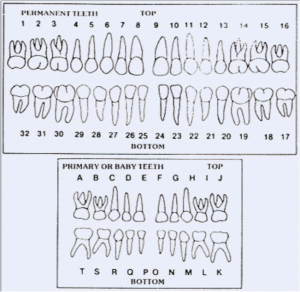Forensic Science Geek of the Week
Thanks to the combined inspiration of Christine Funk, Esquire and Chuck Ramsay, Esquire, a new twist of this blog is being introduced. A weekly fun forensic science challenge/trivia question. The winner will be affectionately dubbed “www.TheTruthAboutForensicScience.com Forensic Science Geek of the Week.”
Rules:
- The challenge will be posted Sunday morning 12 noon EST.
- Answers to the challenge will be entered by responding to this blog post or the www.TheTruthAboutForensicScience.com FaceBook fan page.
- All comments that are answers to this blog will released after 9pm EST.
- The first complete and correct answer will be awarded the envious title of “www.TheTruthAboutForensicScience.com Forensic Science Geek of the Week”
- “www.TheTruthAboutForensicScience.com Forensic Science Geek of the Week” is entitled a one time post of his/her picture on this blog and the www.TheTruthAboutForensicScience.com FaceBook fan page. The coveted title will be his/her for that week. Additionally, a winner will be allowed one link to one webpage of his/her choice. Both the picture and the weblink is subject to the approval of Justin J McShane, Esquire and will only be screened for appropriate taste.
- The winner will be announced Sunday night.
- A winner may only repeat two times in a row, then will have to sit out a week to be eligible again. This person, who was the two time in a row winner, may answer the question, but will be disqualified from the honor so as to allow others to participate.
- This is for learning and for fun. EVERYONE IS ENCOURAGED TO TRY TO ANSWER THE WEEKLY QUESTION. So give it a shot.
Here it is:
The www.TheTruthAboutForensicScience.com “Forensic Science Geek of the Week” challenge question. Remember the first full and complete answer wins the honor and also gets his/her photo displayed, bragging rights for the week and finally website promotion.
OFFICIAL QUESTION:

www.TheTruthAboutForensicScience.com Forensic Science Geek of the Week Questions:
-
-
-
-
- What is the top picture an example of? What discipline does this involve?
- What is the bottom picture of?
- Are there limitations of this discipline?
- The Hall of Fame for the www.TheTruthAboutForensicScience.com Forensic Science Geek of the Week:
- Week 1: Chuck Ramsay, Esquire
- Week 2: Rick McIndoe, PhD
- Week 3: Christine Funk, Esquire
- Week 4: Stephen Daniels
- Week 5: Stephen Daniels
- Week 6: Richard Middlebrook, Esquire
- Week 7: Christine Funk, Esquire
- Week 8: Ron Moore, B.S., J.D.
- Week 9: No one claimed it
- Week 10: IT COULD BE YOU
-
-
-





Kelly W. Case says:
Top picture is bite matching involving dentist or oral surgeon, that has made an impression from the bite mark.
Bottom picture is template of human bite and tooth anatomy.
This “science” has huge limitations, mainly without knowing the actual bite pattern and only using human body bruising as the template, it is almost impossible to develop an accurate mold of the tooth structure. It’s like using jello to make a mold. If a suspect teeth and jaw mold is taken and appears to match, it is very difficult to know whether that is an actual match or an approximation. Junk science at its finest.
Michael Dye says:
I got this…..The field of science is called “forensic ondontology.” It is similar to finger print analysis in the sense that it assumes that the ridges and indientations along the biting edges of an individuals teeth are all different. Which is the first assumption that is wrong. The picture above is a casting of the “suspects” teeth which are then compard to the bitemark on the victim. There are several problems with this “science.” One is the healing process. When an injury like that occurs, there is, for lack of a better discription, collateral damage to the soft tissue surrounding the bite mark. Brusing, cutting from movement during the attack and the healing process skew the results. The casting is usually not compared against the actual injury, but is superimposed after being scanned into a computer, which is similar to photoshop, which is a huge problem for me because I can photoshop the hell out of things.
Additionally,the bitemark pattern usually comes from a photo to create the image which can cause issues with the clarity of the photo, the resolution, angles, lighting etc. The length of time between the attack and the photo will drastically alter the bite mark pattern althought the govt now claims to be able to do some sort of retrograde extrapolation on the bite mark to insure that the overlay is exactly the same as the bitemark when it occurred. In most cases time periods are approximate, so ***cough*** ***cough*** bullshit. Then there is the whole problem we are having down here in NC with the SBI. Since it is basically photoshop software, the tech can make it fit.
So issues: 1) Time of injury; 2) movemant during injury; 3) healing process; 4) assumption that everybody heals the same; 5) false assumption of all teath bite patterns being unique, 6) photo qualiy problems 7) photoshoped evidence, 8) retrograde extrapolation of the healing process.
Forgive my typo’s.
Michael